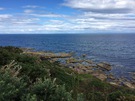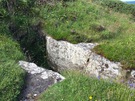Friday, 29 July 2016
Extras
Sculptor's Cave
"Somewhere hereabouts," I wrote in March, "it's allegedly possible to drop down to a cave with 1,500 year-old Pictish carvings."
The soft sandstone of this part of the Moray coast is riddled with caves. The Sculptor's Cave is so-named because of the markings near its entrance that have been dated to about 500 AD. There's a notice near the entrance to help you distinguish the Pictish from the more recent vandalism. In the left-hand image, the markings depicted on the notice are at the top of the photograph. The Pictish markings in the right-hand image are the two concentric rectangles. The central image shows three adjacent ovals and an abstract flower. These are hidden on the ceiling at the entrance to the cave.
There's scant detail online about how to do it, so here I present how to get to Sculptor's Cave.
The cave can only be reached at low tide, so check the tide tables first. Since you'll be doing a little bit of clambering, make sure you've got appropriate footwear.
If you're driving, park on the B9040 at NJ 179 700, about a third of the way from Hopeman to Lossiemouth. There's sufficient space for three or four cars beside the track to the old coastguard lookout. Walk up to the lookout tower.
From the lookout tower at NJ 176 707, turn to face the sea. The cave is a little to the west of this point and below you, but to descend the cliffs you have to go east first. Ignore the Moray Coastal Way, and pick up the old coast path that's ahead of you. It soon bears right and passes a rock ledge on the left that provides a good vantage point to the slopes below. Just after the ledge look out for a gap in the gorse on the left; you should find a less distinct path that leads down to a level grassy area with a rocky cleft in the middle. (There are two routes down to this, approaching the 30cm-by-1m cleft from either side.)
The first of this next group of photos is taken from the old path; the rocky cleft is directly behind the foxglove flower in the middle of the picture. The central photo shows the cleft a little closer, and I took the right-most while standing directly in front of it. This is your way down.
The cleft is the top of a rock chimney (NJ 177 708, about 12m). Hanging on its western wall is a six-runged rope ladder. Test its weight and descend. The rocks at the bottom are slippery so watch out! Use a further bundle of ropes attached lower down to steady you onto the beach.
When you're on the beach, look back at where you've come from; you'll need to be able to find this on the way back. When we visited there was a handy green flag marking it.
That's the difficult bit done! Now scramble over the rocks round the first small headland to the west. There's a fantastic huge cave here, but it's not the one you're looking for. Keep going to the western end of the next shingly cove. Sculptor's Cave is the double-entranced cave at the back of the beach (NJ 175 707).
Visitors had left various bones, sticks and things on a large bolder at the back of the cave, but they're not significant. The carvings are all in the entrance passages.
Keep an eye on the time, and reverse your steps to get out.
As Jez said, there must be thousands of these types of places around the country. You just need to know that they're there and how to find them.














